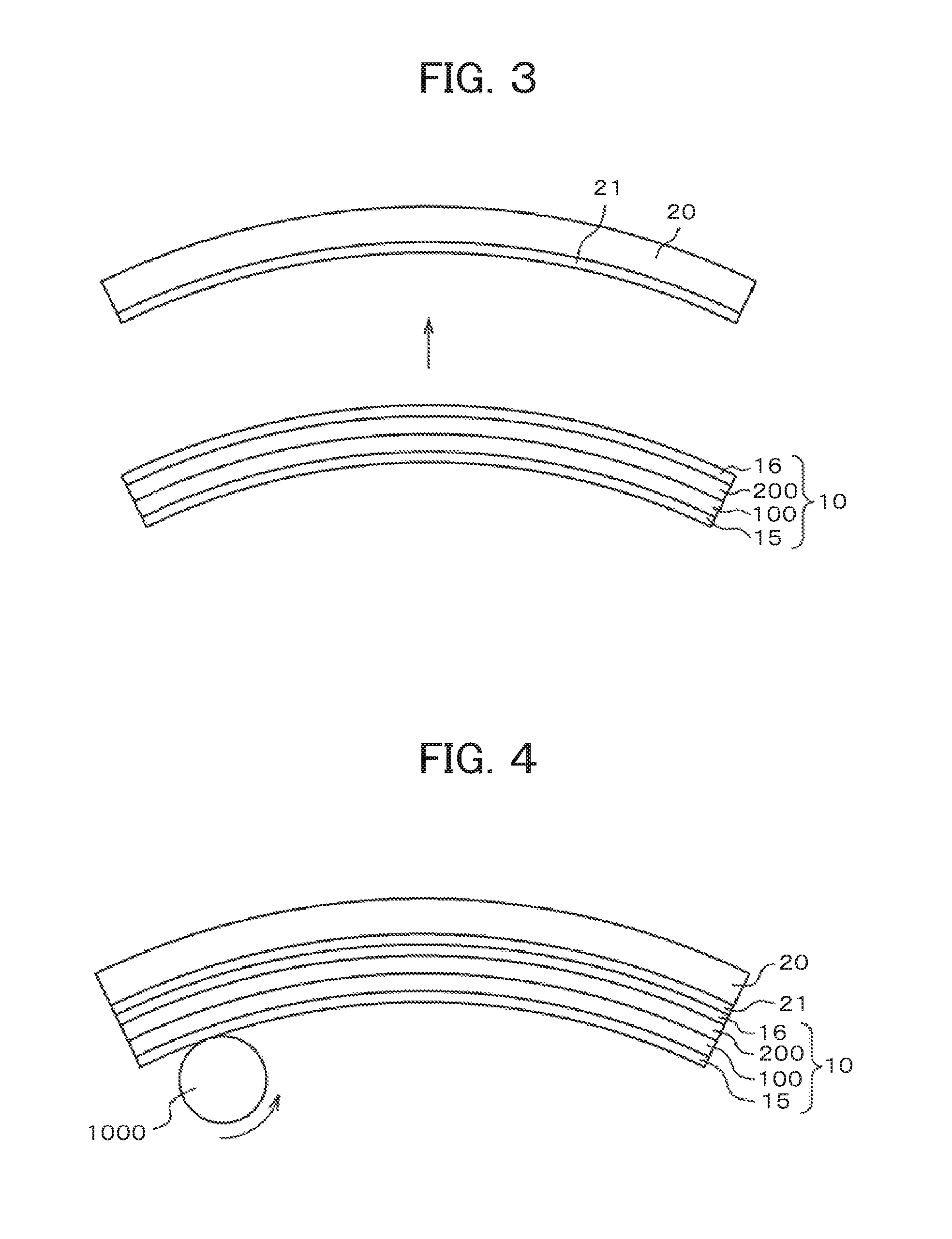Liquid crystal display device
a liquid crystal display and display panel technology, applied in non-linear optics, instruments, optics, etc., can solve the problems of bending of the panel during the manufacturing process, and the panel is already bent when, so as to achieve the effect of not dropping the productivity of the liquid crystal display panel
- Summary
- Abstract
- Description
- Claims
- Application Information
AI Technical Summary
Benefits of technology
Problems solved by technology
Method used
Image
Examples
first embodiment
[0048]FIG. 1 is a perspective view of a curved liquid crystal display device. The display device in FIG. 1 is bent to have its convex screen facing the viewer. In FIG. 1, a protective panel 20 is disposed at the top, under which is a liquid crystal display panel 10. A backlight 30 is disposed at the back of the liquid crystal display panel 10. In FIG. 1, a frame area 12 is formed at the periphery of a rectangular display area 11. In FIG. 1, the long side dimension xx of the display area 11 is 230 mm, its short side dimension yy is 90 mm, and its radius of curvature is 500 mm, for example. FIG. 1 shows an example of a cylindrical curvature. This curvature has a curved axis 13 and an axis 14 perpendicular to the curved axis 13.
[0049]FIG. 2 is a cross-sectional view of a liquid crystal display panel. In FIG. 2, a counter substrate 200 is disposed opposite to a TFT substrate 100 having TFTs and pixel electrodes, among others, formed thereon in a matrix pattern. The TFT substrate 100 and...
second embodiment
[0082]FIG. 11 is a perspective view of a so-called cross spacer configured to determine the gap between the TFT substrate and the counter substrate in the second embodiment of the present invention. As shown in FIG. 11, the gap between the TFT substrate and the counter substrate is determined by a lower bar spacer 60 and an upper bar spacer 70 arranged to make up a cross shape, the lower bar spacer 60 having its long side dimension oriented in the crosswise direction of the TFT substrate, the upper bar spacer 70 having its long side dimension oriented in the longitudinal direction of the counter substrate. The lower bar spacer 60 and the upper bar spacer 70 are collectively called the cross spacer. In FIG. 11, the lower bar spacer 60 is disposed on a scanning line 1, and the upper bar spacer 70 is disposed in a position corresponding to a video signal line 2. Thus many cross spacers are disposed at the intersections between the scanning lines 1 and the video signal lines 2. Contrary...
third embodiment
[0099]As explained above in conjunction with the first and the second embodiments, the pixels formed on the TFT substrate 100 are displaced from the pixels formed on the counter substrate 200 when the liquid crystal display panel 10 is bent into a curved shape. If the center of each pixel on the TFT substrate 100 is made to coincide with the center of each pixel on the counter substrate 200 with the liquid crystal display panel 10 left flat, bending the liquid crystal display panel 10 into a curved shape displaces the pixel centers on the TFT substrate 100 from the pixel centers on the counter substrate 200, particularly at the periphery of the screen. The misalignment causes the light from the backlight having passed through the pixels on the TFT substrate 100 to pass not only through the intended color filter 201 but also through the adjacent color filter 201, bringing about a phenomenon called color mixture.
[0100]To prevent the problem of color mixture requires using a flat liqui...
PUM
| Property | Measurement | Unit |
|---|---|---|
| thickness | aaaaa | aaaaa |
| thickness | aaaaa | aaaaa |
| thickness | aaaaa | aaaaa |
Abstract
Description
Claims
Application Information
 Login to View More
Login to View More - R&D
- Intellectual Property
- Life Sciences
- Materials
- Tech Scout
- Unparalleled Data Quality
- Higher Quality Content
- 60% Fewer Hallucinations
Browse by: Latest US Patents, China's latest patents, Technical Efficacy Thesaurus, Application Domain, Technology Topic, Popular Technical Reports.
© 2025 PatSnap. All rights reserved.Legal|Privacy policy|Modern Slavery Act Transparency Statement|Sitemap|About US| Contact US: help@patsnap.com



